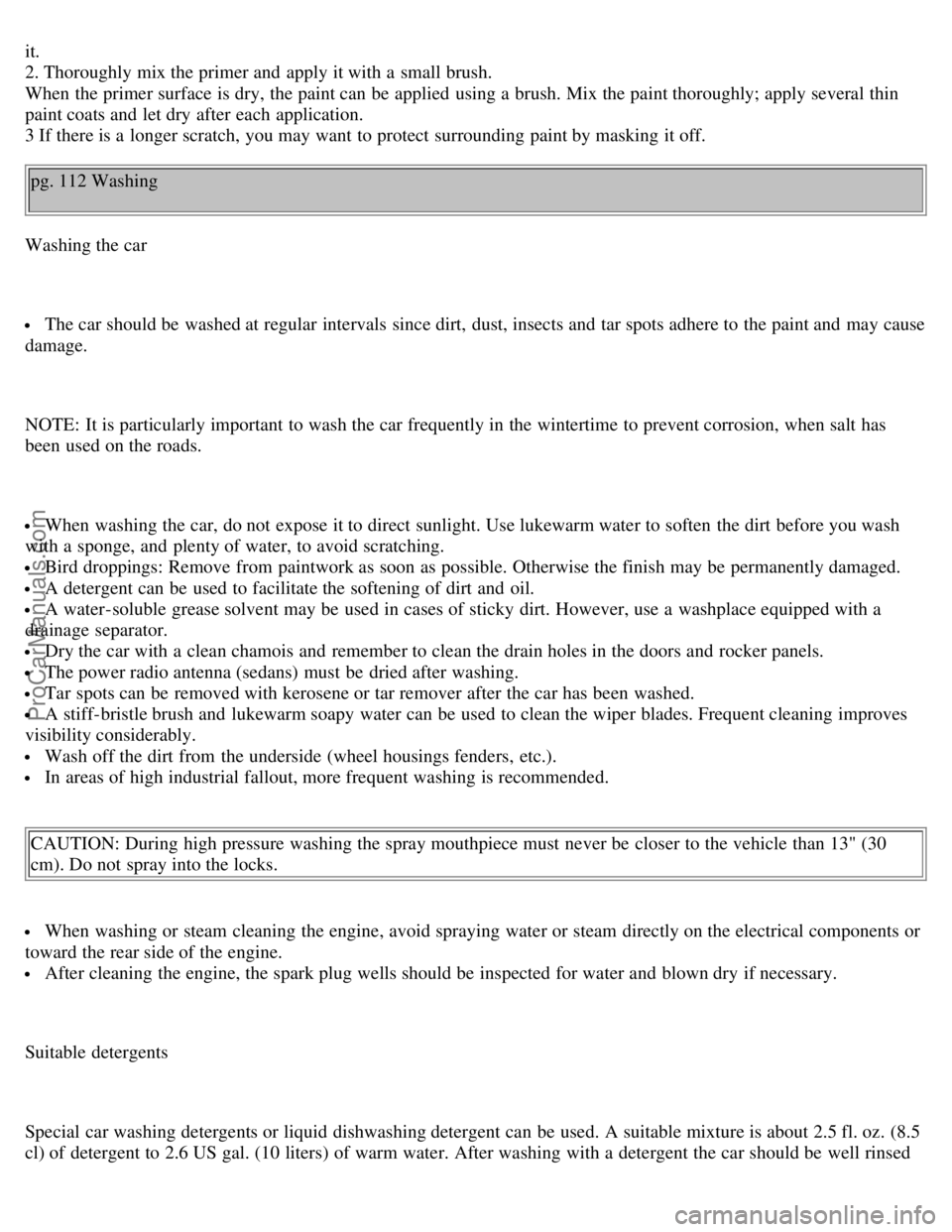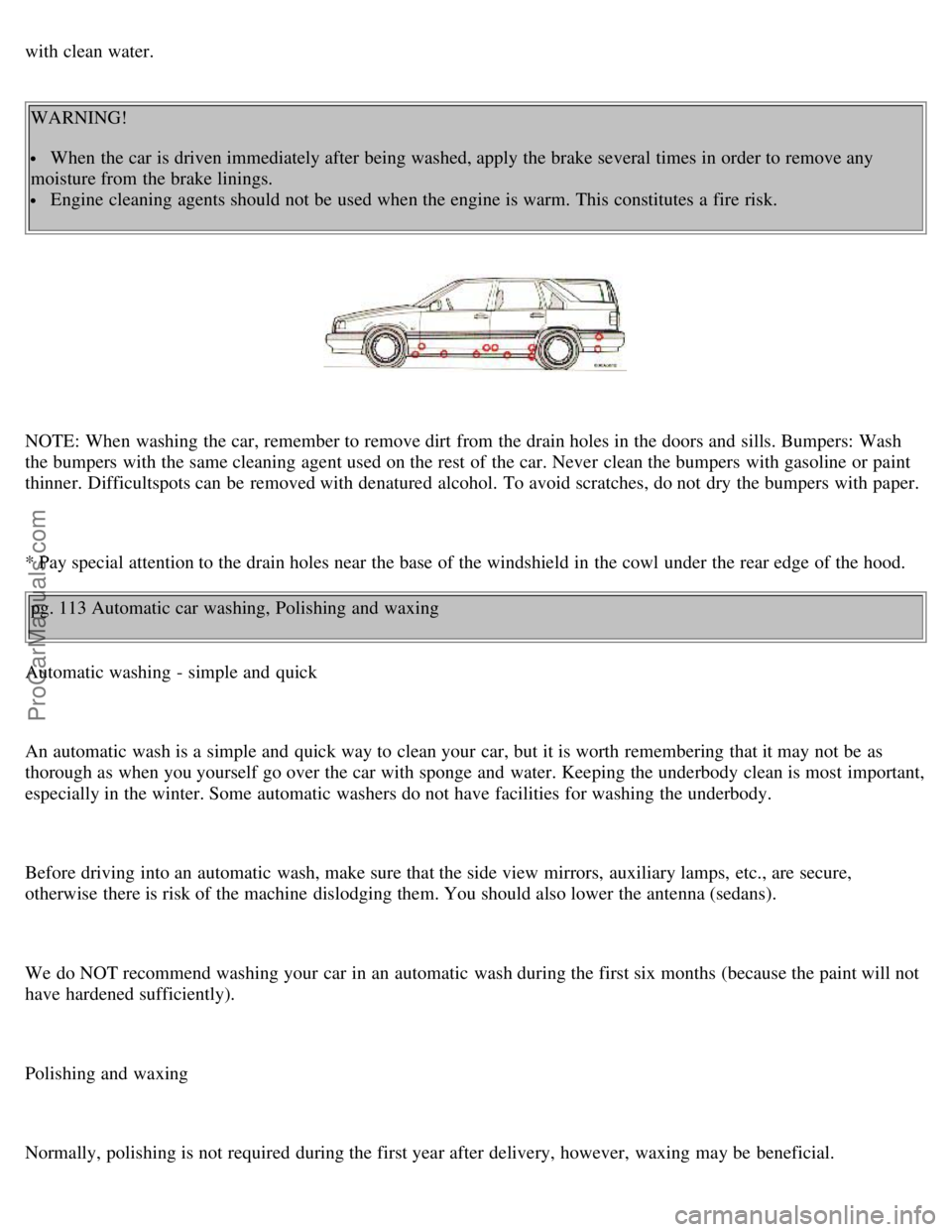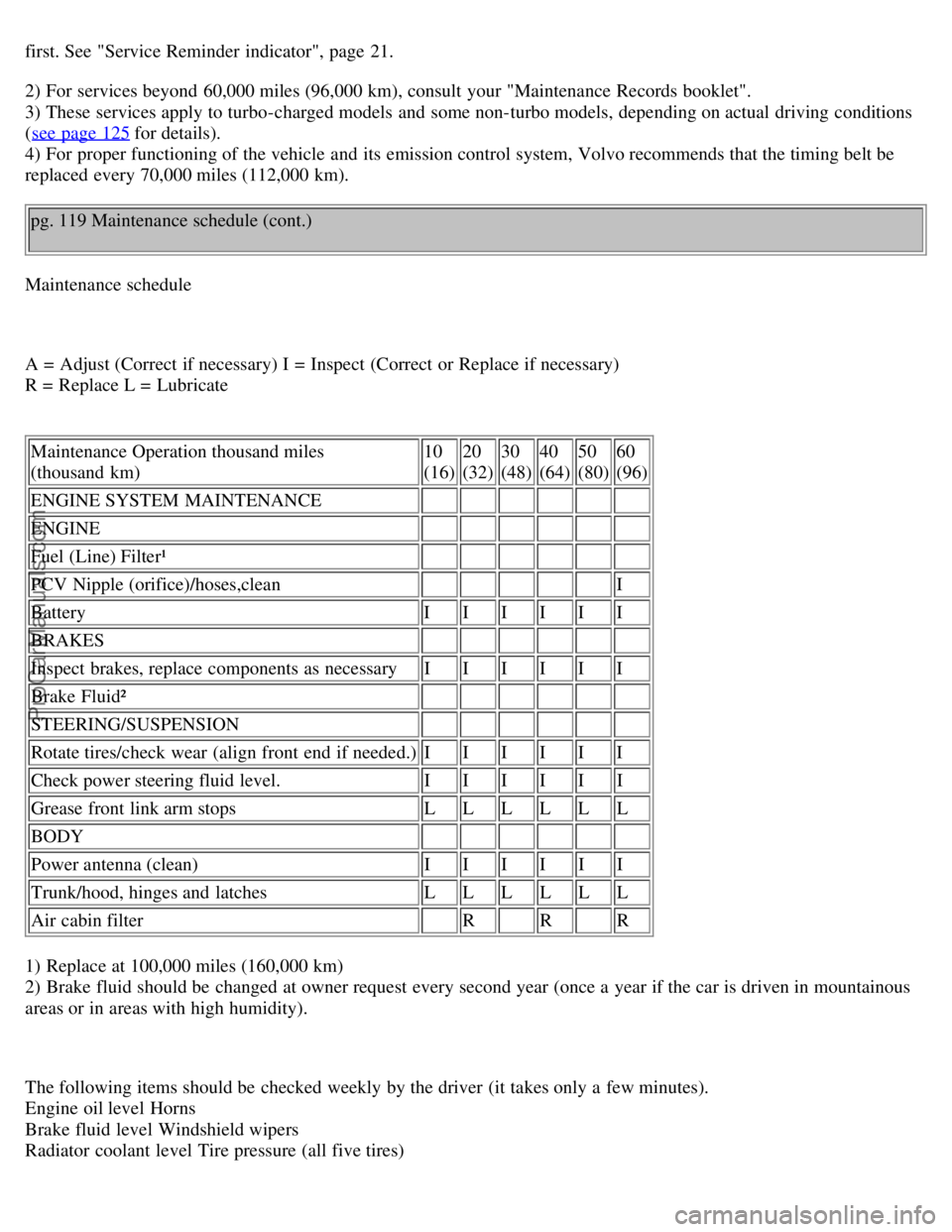VOLVO S70 1998 Owner's Guide
Manufacturer: VOLVO, Model Year: 1998, Model line: S70, Model: VOLVO S70 1998Pages: 52, PDF Size: 0.89 MB
Page 31 of 52

Chapter 7 - Car care
pg. 109 Car care
Car care
Car care includes not only maintaining the appearance of the car, but also protecting the car exterior from the effects of
air pollution, rain, mud or road salt. The paintwork should also be touched up immediately, if damaged, to preventrust
formation. Page No. Subject
pg. 110-111
Paint touch-up
pg. 112
Washing
pg. 113
Automatic car washing, Polishing and waxing
pg. 114
Cleaning the upholstery
pg. 110 Paint touch-up
Paint touch-up
Paint damage requires immediate attention to avoid rusting. Make it a habit to check the finish regularly - when
washing the car for instance. Touch up if necessary.
Paint repairs require special equipment and skill. Contact your Volvo retailer for any extensive damage.
Minor scratches can be repaired by using Volvo touch-up paint.
NOTE: When ordering touch-up paint from your Volvo retailer, use the paint code indicated on the model plate. The
plate is located in the engine compartment, on the inside of the left front fender.
Minor stone chips and scratches
Material:
Primer - can
ProCarManuals.com
Page 32 of 52

Paint - touch-up bottle
Brush
Masking tape
NOTE: When touching up the car, it should be clean and dry. The surface temperature should be above 60° F (15° C).
Scars on the surface
If the stone chip has not penetrated down to the metal and undamaged layer of paint remains, the touch-up paint can be
applied as soon as the spot has been cleaned.pg. 111 Paint touch-up (cont.)
Deep scars
1. Place a strip of masking tape over the damaged surface. Pull the tape off so that any loose flakes of paint adhere to
ProCarManuals.com
Page 33 of 52

it.
2. Thoroughly mix the primer and apply it with a small brush.
When the primer surface is dry, the paint can be applied using a brush. Mix the paint thoroughly; apply several thin
paint coats and let dry after each application.
3 If there is a longer scratch, you may want to protect surrounding paint by masking it off.pg. 112 Washing
Washing the car
The car should be washed at regular intervals since dirt, dust, insects and tar spots adhere to the paint and may cause
damage.
NOTE: It is particularly important to wash the car frequently in the wintertime to prevent corrosion, when salt has
been used on the roads.
When washing the car, do not expose it to direct sunlight. Use lukewarm water to soften the dirt before you wash
with a sponge, and plenty of water, to avoid scratching.
Bird droppings: Remove from paintwork as soon as possible. Otherwise the finish may be permanently damaged.
A detergent can be used to facilitate the softening of dirt and oil.
A water-soluble grease solvent may be used in cases of sticky dirt. However, use a washplace equipped with a
drainage separator.
Dry the car with a clean chamois and remember to clean the drain holes in the doors and rocker panels.
The power radio antenna (sedans) must be dried after washing.
Tar spots can be removed with kerosene or tar remover after the car has been washed.
A stiff-bristle brush and lukewarm soapy water can be used to clean the wiper blades. Frequent cleaning improves
visibility considerably.
Wash off the dirt from the underside (wheel housings fenders, etc.).
In areas of high industrial fallout, more frequent washing is recommended.
CAUTION: During high pressure washing the spray mouthpiece must never be closer to the vehicle than 13" (30
cm). Do not spray into the locks.
When washing or steam cleaning the engine, avoid spraying water or steam directly on the electrical components or
toward the rear side of the engine.
After cleaning the engine, the spark plug wells should be inspected for water and blown dry if necessary.
Suitable detergents
Special car washing detergents or liquid dishwashing detergent can be used. A suitable mixture is about 2.5 fl. oz. (8.5
cl) of detergent to 2.6 US gal. (10 liters) of warm water. After washing with a detergent the car should be well rinsed
ProCarManuals.com
Page 34 of 52

with clean water.
WARNING!
When the car is driven immediately after being washed, apply the brake several times in order to remove any
moisture from the brake linings.
Engine cleaning agents should not be used when the engine is warm. This constitutes a fire risk.
NOTE: When washing the car, remember to remove dirt from the drain holes in the doors and sills. Bumpers: Wash
the bumpers with the same cleaning agent used on the rest of the car. Never clean the bumpers with gasoline or paint
thinner. Difficultspots can be removed with denatured alcohol. To avoid scratches, do not dry the bumpers with paper.
* Pay special attention to the drain holes near the base of the windshield in the cowl under the rear edge of the hood.
pg. 113 Automatic car washing, Polishing and waxing
Automatic washing - simple and quick
An automatic wash is a simple and quick way to clean your car, but it is worth remembering that it may not be as
thorough as when you yourself go over the car with sponge and water. Keeping the underbody clean is most important,
especially in the winter. Some automatic washers do not have facilities for washing the underbody.
Before driving into an automatic wash, make sure that the side view mirrors, auxiliary lamps, etc., are secure,
otherwise there is risk of the machine dislodging them. You should also lower the antenna (sedans).
We do NOT recommend washing your car in an automatic wash during the first six months (because the paint will not
have hardened sufficiently).
Polishing and waxing
Normally, polishing is not required during the first year after delivery, however, waxing may be beneficial.
ProCarManuals.com
Page 35 of 52

Before applying polish or wax the car must be washed and dried. Tar spots can be removed with kerosene or tar
remover. Difficult spots may require a fine rubbing compound.
After polishing use liquid or paste wax.
Several commercially available products contain both polish and wax.
Waxing alone does not substitute for polishing of a dull surface.
A wide range of polymer-based car waxes can be purchased today. The waxes are easy to use and produce a long-
lasting, high-gloss finish that protects the bodywork against oxidation, road dirt and fading.pg. 114 Cleaning the upholstery
Cleaning the upholstery
The fabric can be cleaned with soapy water or a detergent. For more difficult spots caused by oil, ice cream, shoe
polish, grease, etc., use a clothing/clothing fabric stain remover.
The plastic in the upholstery can be cleaned with a soft cloth and mild soap solution.
Leather upholstery/suede-like upholstery (alcantera) can be cleaned with a soft cloth and mild soap solution. For more
different spots, Volvo offers a leather care kit.
On no account must gasoline, naphtha or similar cleaning agents be used on the plastic or the leather since these can
cause damage.
Cleaning the seat belts
Clean only with lukewarm water and mild soap solution.
ProCarManuals.com
Page 36 of 52

Cleaning floor mats
The floor mats should be vacuumed or brushed clean regularly, especially during winter when they should be taken out
for drying. Spots on textile mats can be removed with a mild detergent.
Bear in mind
Take extra care when removing stains such as ink or lipstick since the coloring can spread.
Use solvents sparingly. Too much solvent can damage the seat padding.
Start from the outside of the stain and work toward the center.
Contents | Top of Page
ProCarManuals.com
Page 37 of 52

Chapter 8 - Service and routine maintenance
pg. 115 Volvo Service
Service - an investment
An investment which will pay dividends in the form of improved reliability, durability, and resale value. Page No. Subject
pg. 116
Label information
pg. 117
Maintenance service, Warranty
pg. 118-119
Maintenance schedule
pg. 120-121
Servicing
pg. 122
Fuel/emissions systems
pg. 123
Lubrication
pg. 124-125
Engine oil
pg. 126
Power steering fluid, Brake/clutch system fluid reservoir
pg. 127
Automatic transmission fluid
pg. 128
Drive belt, Air pump system
pg. 129
Windshield washer nozzle, Washer fluid reservoir
pg. 130
Coolant
pg. 131
Engine compartment
pg. 132
Battery maintenance
pg. 116 Label information
1 Vehicle Emission Control Information
Your Volvo is designed to meet all applicable emission standards, as evidenced by the certification label on the
underside of the hood. For further information regarding these regulations, please consult your Volvo retailer.
2 Vacuum hose routing
(underside of hood)
3 Loads and Tire Pressures
(on inside of fuel tank cover)
4 Model plate
Vehicle Identification Number (VIN). Codes for color and upholstery etc. The plate is located in the engine
compartment, on the inside of left front fender. headlight.
5 Vehicle Identification Number (VIN) *
The VIN plate is located on the top left surface of the dashboard. The VIN is also stamped on the right hand door
pillar.
6 Federal Motor Vehicle Safety Standards (FMVSS) specifications (USA) and Ministry of Transport (CMVSS)
Standards (Canada)
Your Volvo is designed to meet all applicable safety standards, as evidenced by the certification label on the facing
side of the driver's door. For further information regarding these regulations, please consult your Volvo retailer.
7 Child safety latch label
ProCarManuals.com
Page 38 of 52

* The Vehicle Identification Number (VIN) should always be quoted in all correspondence concerning your vehicle
with the retailer and when ordering parts.
** These decals are located on the underside of the hood.
All specifications are subject to change without notice.pg. 117 Maintenance service, Warranty
Maintenance service
Volvo advises you to follow the service program which is outlined in the "Maintenance Records Manual". This
maintenance program contains inspections and services necessary for the proper function of your car. The maintenance
services contain several checks which require special instruments and tools and therefore must be performed by a
qualified technician. To keep your Volvo in top condition, specify time tested and proven Genuine Volvo Parts and
Accessories.
The Federal Clean Air Act - U.S.
The Clean Air Act requires vehicle manufacturers to furnish written instructions to the ultimate purchaser to assure the
proper functioning of those components that control emissions. The maintenance instructions listed in the "Servicing"
section of this Manual represent the minimum maintenance required. These services are not covered by the warranty.
You will be required to pay for labor and material used. Refer to your Warranty booklet for further details.
ProCarManuals.com
Page 39 of 52

Maintenance services
Your Volvo has passed several major inspections before being delivered to you, according to Volvo specifications. The
maintenance services outlined in this book should be performed as indicated. The extended maintenance service
intervals make it even more advisable to follow this program. Inspection and service should also be performed any
time a malfunction is observed or suspected. It is recommended that receipts for vehicle emission services be retained
in the event that questions arise concerning maintenance. See your "Maintenance Records Manual".
Applicable warranties - U.S.
In accordance with U.S. Federal Regulations, the following list of applicable U.S. warranties is provided. For Canadian
specification vehicles, see your separate warranty booklet.
New Car Limited Warranty
Parts and Accessories Limited Warranty
Corrosion Protection Limited Warranty
Seatbelt and Supplemental Restraint Systems Limited Warranty
Emission Design and Defect Warranty
Emission Performance Warranty
These are the Federal warranties; other warranties are provided as required by state law. Refer to your separate
Warranty booklet for detailed information concerning each of the warranties. pg. 118 Maintenance schedule
Maintenance schedule
A = Adjust (Correct if necessary) I = Inspect (Correct or Replace if necessary)
R = Replace L = Lubricate
Maintenance Operation thousand miles
(thousand km) 5³
(8)10
(16) 15³
(25)20
(32)25³
(40)30
(48)35³
(56)40
(64)45³
(72)50
(80)55³
(88)60²
(96)
EMISSION SYSTEM MAINTENANCE
Engine oil and filter¹ R³R R³RR³RR³RR³RR³R
Engine drive belt (accessory belt) I
Air cleaner filter RR
Spark plugs RR
Automatic transmission fluid IIIIII
Timing belt - all engines
NOTE: The oil should be changed at these intervals or after 750 hours of driving or after 12 months which ever occurs
ProCarManuals.com
Page 40 of 52

first. See "Service Reminder indicator", page 21.
2) For services beyond 60,000 miles (96,000 km), consult your "Maintenance Records booklet".
3) These services apply to turbo-charged models and some non-turbo models, depending on actual driving conditions
(see page 125
for details).
4) For proper functioning of the vehicle and its emission control system, Volvo recommends that the timing belt be
replaced every 70,000 miles (112,000 km).
pg. 119 Maintenance schedule (cont.)
Maintenance schedule
A = Adjust (Correct if necessary) I = Inspect (Correct or Replace if necessary)
R = Replace L = Lubricate
Maintenance Operation thousand miles
(thousand km) 10
(16)20
(32)30
(48)40
(64)50
(80)60
(96)
ENGINE SYSTEM MAINTENANCE
ENGINE
Fuel (Line) Filter¹
PCV Nipple (orifice)/hoses,clean I
Battery IIIIII
BRAKES
Inspect brakes, replace components as necessary IIIIII
Brake Fluid²
STEERING/SUSPENSION
Rotate tires/check wear (align front end if needed.) IIIIII
Check power steering fluid level. IIIIII
Grease front link arm stops LLLLLL
BODY
Power antenna (clean) IIIIII
Trunk/hood, hinges and latches LLLLLL
Air cabin filter RRR
1) Replace at 100,000 miles (160,000 km)
2) Brake fluid should be changed at owner request every second year (once a year if the car is driven in mountainous
areas or in areas with high humidity).
The following items should be checked weekly by the driver (it takes only a few minutes).
Engine oil level Horns
Brake fluid level Windshield wipers
Radiator coolant level Tire pressure (all five tires)
ProCarManuals.com